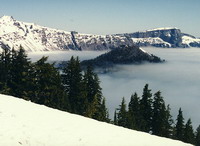Login form
Oregon

Would you believe that the deepest lake in the United States is on top of a mountain? It’s true. Crater Lake lies on the peak of a mountain in the Cascade Range in Oregon. The lake is nearly 2,000 feet (600 meters) deep.
CRATER LAKE
Crater Lake formed after a volcano blew its top about 7,700 years ago. Rain and melted snow then filled the bowl-shaped hole, or crater, left by the explosion. Today, this brilliant blue lake looks peaceful. It’s one of many beautiful areas in Oregon.
|
Facts About Oregon |
|
|
|
|
|
Capital |
Salem |
|
Population |
3,560,000 people |
|
Rank among states in population |
27th |
|
Major cities |
Portland, Eugene, Salem |
|
Area |
98,400 square miles |
|
Rank among states in area |
10th |
|
Statehood |
February 14, 1859, the 33rd state |
|
State nickname |
The Beaver State |
|
Name for residents |
Oregonians |
|
State bird |
Western Meadowlark |
|
State flower |
Oregon Grape |
|
State tree |
Douglas Fir |
|
Abbreviation |
OR |
OREGON’S SCENIC BEAUTY
Oregon is noted for the beauty of its scenery. It has a dramatic, windswept coast along the Pacific Ocean. Rugged cliffs rise along part of Oregon’s coastline. Elsewhere, sandy beaches and dunes spread out along the coast.
Cannon Beach on Oregon’s Pacific coast attracts many tourists. Near the shore, a large rock shaped like a haystack rises 235 feet. Birds nest on Haystack Rock. Lots of sea creatures live around it. Each summer, the town of Cannon Beach holds a sand castle contest. People build castles and other elaborate structures on the beach.
The Cascades have other volcanic peaks besides Crater Lake. The most spectacular is snow-capped Mount Hood. Oregon’s mountains and many forests offer lots of opportunities for hiking, climbing, fishing, and boating. Skiing and other winter sports are popular on the slopes of Mount Hood.
THE COLUMBIA RIVER
The Columbia River forms much of the border between Oregon and the state of Washington. East of the city of Portland, Oregon, the river cuts a deep canyon known as the Columbia River Gorge. This region of the Columbia is another area of beautiful scenery.
In 1805, the explorers Meriwether Lewis and William Clark followed the Columbia River to the Pacific Ocean. After their 18-month journey to the Pacific, Lewis and Clark spent the winter in a log fort they built near Astoria. You can see a replica of their winter camp at Fort Clatsop National Memorial.
THE BEAVER STATE
Oregon is nicknamed the Beaver State. In the early 19th century, beaver fur was valuable. Beaver top hats had become the fad among wealthy men in Europe. Oregon’s streams were full of beaver. They drew many fur trappers to the area. The fur trade became big business. John Jacob Astor headed the American Fur Company and founded Astoria, Oregon.
Fur traders founded trading posts in Oregon. They also marked paths that settlers could follow. Oregon entered the Union on February 14, 1859, as the 33rd state. Salem is Oregon’s capital. It was founded in 1840. Today, Portland, on the Willamette River in northwestern Oregon, is the state’s largest city.
THE OREGON TRAIL
Thousands of pioneers followed the Oregon Trail west. The trail began in Independence, Missouri, and ended in Oregon, 2,000 miles (3,200 kilometers) further west. It took about six months to cover this distance by wagon train. The pioneers walked most of the way. The wagons carried their belongings and the supplies they needed for the journey.
Near the end of the Oregon Trail, pioneers had to float their wagons down the Columbia River. The waters of the Columbia flowed swiftly and proved treacherous. Even with the help of Native American guides, some pioneers drowned in the fast-moving river.
The Oregon Trail operated from 1841 until the 1860s. You can learn about it at the Oregon Trail Interpretive Center in Oregon City. Several other nearby sites provide information about pioneer life in Oregon.
THE WILLAMETTE VALLEY
What took pioneers on such a long and difficult journey to Oregon? It was the promise of free land in a fertile area—the valley of the Willamette River. By 1850, a married couple could receive 640 acres (260 hectares) of free land in Oregon. Native Americans lost their land when it was given as farmland to white settlers.
The settlers found the Willamette Valley was good for growing fruit, vegetables, and wheat. They set up mills at waterfalls along the Willamette River. Today, the Willamette Valley is the most populated region in Oregon. It still supports wheat fields, fruit orchards, and dairy farms. Portland and Salem both lie on the banks of the Willamette. The Willamette River starts near the city of Eugene.
OREGON’S FORESTS
Oregon’s economy has long depended on its natural resources, especially its fertile farmland and vast forests. Forests cover nearly half of Oregon’s land. The forests provide lumber. Oregon is the leading lumber producer in the United States. Most of Oregon’s lumber comes from the Douglas fir.
The use of Oregon’s natural resources has at times put industry at odds with the environmental movement. The United States government has listed the northern spotted owl as a threatened species. This owl lives in Oregon forests. In 1990, the threat to the spotted owl led to restrictions on logging in Oregon. The logging industry has objected to these restrictions, as have loggers who fear losing their jobs.
Source: Microsoft ® Encarta

